

Educational Reform and Inequality in a Privatized Educational System. Alejandra Mizala and Florencia Torche Universidad de Chile Stanford University amizala@dii.uchile.cl torche@stanford.edu November 3, 2017 Mizala & Torche Educational reform and inequality November 3, 2017 1 / 15
Introduction Chile features a “universal school voucher system” since the early 1980s, a market-based educational system with substantial private provision. This project evaluates a major policy reform to reduce educational inequality in this context. Consequences and limits of the policy reform intended to reduce inequality in context of privatized educational system. Mizala & Torche Educational reform and inequality November 3, 2017 2 / 15
The Chilean educational voucher system In 1981, universal voucher system was implemented. Government paid per-student voucher to all public and private schools in exchange for not charging tuition. Students could use voucher in the school of their choice with (in principle) no restrictions. Objectives: Fostering competition and providing choice. Mizala & Torche Educational reform and inequality November 3, 2017 3 / 15
Share of enrollment by school sector, Chile 1981-2014. Mizala & Torche Educational reform and inequality November 3, 2017 4 / 15
School enrollment across school sector by income decile: Chile 1990. Mizala & Torche Educational reform and inequality November 3, 2017 5 / 15
School enrollment across school sector by income decile: Chile 2014. Mizala & Torche Educational reform and inequality November 3, 2017 6 / 15
Chilean voucher system: Institutional design Voucher is flat, without adjustment for student’s economic need. Private-voucher schools allowed to select and expel students. Private-voucher schools allowed to charge add-on funds to parents (since 1993). Combination of these design features provides strong incentives for schools to select students based on socioeconomic and academic advantage, and allows them to do so. Mizala & Torche Educational reform and inequality November 3, 2017 7 / 15
Policy reform: From flat to means-tested voucher In 2008, Congress passed the SEP law, which transforms flat into means-tested voucher. Law increasing the voucher amount based on students’ poverty level and on proportion of poor students in the school. Objectives were to compensate schools for what disadvantaged students “really cost” and to provide incentives to enroll them. Law also included increased accountability of schools taking the additional voucher (schools should enroll all applicants or select by lottery, should not expel students, should not charge add-on fees, should improve performance of disadvantaged students). Mizala & Torche Educational reform and inequality November 3, 2017 8 / 15
Value of means-tested voucher 2005-2014. Light gray: Flat voucher. Medium gray: Voucher + additional compensation for poverty. Dark gray: Voucher + addl. compensation for poverty + Addl compensation for poverty concentration. Mizala & Torche Educational reform and inequality November 3, 2017 9 / 15
Uptake of means-tested voucher 2005-2014. Mizala & Torche Educational reform and inequality November 3, 2017 10 / 15
Effect of the means-tested voucher Achievement : What is the effect of the means-tested voucher on school-level math and reading test scores ? Inequality of achievement : Does the effect vary by economic disadvantage? Timing : Does the effect vary with time elapsed since the school takes the means-tested voucher policy? School-year panel 2005-2014 combines 4th grade test-scores with family census. Fixed effects models exploit staggered uptake of means-tested voucher policy to account for unobserved time-invariant school attributes. Mizala & Torche Educational reform and inequality November 3, 2017 11 / 15
Effect on test scores FE models, solid dots are parameter estimates, vertical lines are 95% CIs. Robust standard errors clustered at the school level. Schools with ¡12 students taking standardized test excluded (3% students, 17% schools). Controls include school-level mean of mothers schooling, fathers schooling, and total family income. Sample weighted by elementary-school enrollment. Mizala & Torche Educational reform and inequality November 3, 2017 12 / 15
Inequality: Effect on test scores by family income Mizala & Torche Educational reform and inequality November 3, 2017 13 / 15
Effect over time after uptake Mizala & Torche Educational reform and inequality November 3, 2017 14 / 15
Conclusion and further questions Success story: Moving to a means-tested voucher appears to increase overall educational achievement and reduce economic gaps in achievement. School appear to take time to fully benefit from the policy. (Effect appears to be driven by increased support of schools rather than resorting or competition). Policy reform “works around the edges” of privatized, marketized system. Schools are already finding ways to select students, to charge “technical fees” to families, etc. Mizala & Torche Educational reform and inequality November 3, 2017 15 / 15
Recommend
More recommend